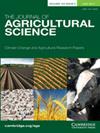巴西大豆黑霉病危害评价(双翅目:黑霉科)
IF 1.7
4区 农林科学
Q2 AGRICULTURE, MULTIDISCIPLINARY
引用次数: 0
摘要
大豆茎蝇(Melanagromyza sojae Zehntner)是一种重要的东亚大豆(甘氨酸max)害虫,最近在南美洲定居。大豆m.s ajae的殖民地区包括巴西和其他几个主要的大豆种植国。由于缺乏有关其危害大豆的信息,这种害虫的管理策略在很大程度上仍未开发。本研究的目的是量化大豆芽孢杆菌造成的大豆减产。其中一项试验于2020年和2021年两个夏季作物季节在巴西RS州的Santa Maria进行。大豆在季末播种,以确保田间大豆黑穗病成虫的高压存在。对下、中、上层冠层的种子数、千粒重、种子产量和荚果数进行量化,并将株高与伤茎量进行比较,确定伤茎百分比。下、中、上冠段每伤1%,单株种子数、千粒重和产量均显著降低。在所有冠层段中,每1%的茎损伤产量减少0.9 g /株。在营养阶段开始施用杀虫剂的处理对大豆病菌的危害最小。这些数据表明,在巴西的生长条件下,大豆稻蠹是一种经济上重要的大豆食草动物,并强调需要制定有效和可持续的管理策略来对付这种害虫。本文章由计算机程序翻译,如有差异,请以英文原文为准。
Damage Assessment of Melanagromyza sojae (Diptera: Agromyzidae) on Soybean in Brazil
Soybean stem fly, Melanagromyza sojae Zehntner (Diptera: Agromyzidae), is an important soybean (Glycine max) pest in Eastern Asia that has recently colonized South America. The region colonized by M. sojae includes Brazil and several other major soybean growing countries. Management strategies for this pest remain largely undeveloped due to lack of information regarding its potential to injury soybeans. The objective of this study was to quantify soybean yield reduction caused by M. sojae injury. One experiment was carried out during two summer crop seasons (2020 and 2021) at Santa Maria, RS state, Brazil. Soybean was planted during late-season to ensure that high pressure of M. sojae adults were present in the fields. The number of seeds, 1,000-seed weight, seed yield and number of pods were quantified for the lower, middle and upper canopy, and plant height was compared to the amount of stem injured to determine percentage of injured stem. Each 1% of injured stem in the lower, middle and upper canopy segments significantly reduced the number of seeds per plant, 1,000-seed weight, and yield. Across all canopy segments, yield reduction reached 0.9 g per plant for every 1% of injured stem. Treatments where insecticide applications started during the vegetative phase presented the lowest damage by M. sojae. These data suggest that M. sojae is an economically important herbivore of soybeans under Brazilian growing conditions and highlight the need to develop efficient and sustainable management strategies for this pest.
求助全文
通过发布文献求助,成功后即可免费获取论文全文。
去求助
来源期刊

Journal of Agricultural Science
农林科学-农业综合
CiteScore
2.80
自引率
5.00%
发文量
68
审稿时长
1.4 months
期刊介绍:
The Journal of Agricultural Science publishes papers concerned with the advance of agriculture and the use of land resources throughout the world. It publishes original scientific work related to strategic and applied studies in all aspects of agricultural science and exploited species, as well as reviews of scientific topics of current agricultural relevance. Specific topics of interest include (but are not confined to): all aspects of crop and animal physiology, modelling of crop and animal systems, the scientific underpinning of agronomy and husbandry, animal welfare and behaviour, soil science, plant and animal product quality, plant and animal nutrition, engineering solutions, decision support systems, land use, environmental impacts of agriculture and forestry, impacts of climate change, rural biodiversity, experimental design and statistical analysis, and the application of new analytical and study methods (including genetic diversity and molecular biology approaches). The journal also publishes book reviews and letters. Occasional themed issues are published which have recently included centenary reviews, wheat papers and modelling animal systems.
 求助内容:
求助内容: 应助结果提醒方式:
应助结果提醒方式:


